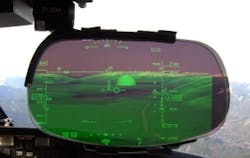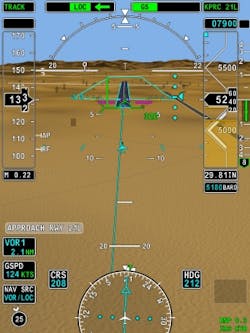Convergence: synthetic vision & enhanced vision
The second part of a two-part story by Charlotte AdamsSynthetic and enhanced vision systems (SVS/EVS) are converging in the cockpit, marking another milestone on the road to equivalent visual operations, a key NextGen concept. Equivalent visual operations would mean operating with visual flight rules (VFR)-like procedures in instrument conditions.Rockwell Collins in Cedar Rapids, Iowa is introducing synthetic vision and enhanced vision on the head-up display (HUD) as a matter of pilot selection. Honeywell is taking the “next step” -- a combined vision system (CVS) that blends synthetic and infrared (IR) elements on a single display. Meanwhile the search is accelerating for initial SVS and expanded EVS operational credit.The beauty of synthetic vision -- head-down or head-up -- is that it’s "weather-agnostic," says Capt. Mark Schlegel, senior engineering test pilot at Bombardier’s Flight Test Center in Wichita, Kan. SVS is a database system that will present a clear image of the terrain and airport features at all times. SVS, head-down or head-up, significantly improves the flight crew's situational awareness, and therefore safety, in low-visibility conditions in all phases of flight, he says. Having SVS and EVS on the HUD, however, allows a head-up transition from SVS to EVS and then to the pilot's natural vision. Rockwell Collins’ Pro Line Fusion SVS and EVS will debut on Bombardier’s Global Express and Global 5000.HoneywellHoneywell is blending SVS and EVS on the primary flight display (PFD), a project that could be approved as soon as 2013. Controlling the presentation is a set of rules that adapt the display to weather conditions and the aircraft’s phase of flight.Honeywell focuses SVS on the head-down display. There is a definite case to be made that SVS imagery allows the pilot a much quicker and more natural transition from the head-down to the head-up environment, compared with older instrumentation, says Chad Cundiff, vice president of crew interface products at Honeywell. Honeywell data indicates that manual flight is much more accurate with SVS than without it. An operator with enhanced flight vision system (EFVS), a specially certified EVS on the HUD -- and no SVS -- can already go down to 100 feet before acquiring the runway with the naked eye. This is 50 feet lower than what RTCA is attempting to achieve with SVS. However, there are many pilots without HUDs who would like to add head-down SVS if they could get lower decision height (DH), decision altitude (DA) or runway visual range (RVR) minimums. The emerging, combined display would also help the pilot-not-flying to monitor the approach, Cundiff says, since the PNF typically does not have a HUD.
At the center of the blended display, infrared imagery appears within a portrait-style rectangle, which the pilot can turn off at any time. The appearance of the display changes between phases of flight. The IR image is also “colorized,” using the SVS color palette.The biggest change in the display occurs between the enroute and the approach modes, says Trish Ververs, a Honeywell human factors scientist. In the approach mode, once the landing gear is deployed, the display declutters -- fades out the runway centerline and splits the pitch bar -- to open up the center of the display, helping the pilot to detect the approach lights. In the approach mode the IR image is also “semitransparent” above the zero pitch line, so that the pilot, for example, can see “SVS mountains” through the IR block data. SVS HUDRockwell Collins’ breakthrough is getting SVS on the HUD. With the HUD’s exceptional record as a pathway to credit, Rockwell Collins is trying to position itself for early SVS operational dividends. Pro Line Fusion, however, also features a full-color SVS display on the PFD with what the company asserts is the highest-resolution terrain data commercially available.Rockwell Collins presents essentially the same SVS image head-up as head-down, except for a little “tailoring of the scene” on the HUD because of it monochromatic nature, says Paul Boucher, Rockwell Collins director of commercial head-up guidance system programs. The SVS image on the HUD is also slightly truncated (1.5 degrees on each side), compared with the head-down display because of the HUD’s smaller field of view.The HGS-6000 HUD uses multiple shades of green to render the synthetic terrain. The major differences between the synthetic scene on the HUD and the natural scene outside -- apart from the monochrome head-up presentation -- are the airport dome symbols, the extended runway centerline and some other features close in to the airport. Domes are visible for the origin, destination and alternate airports -- head-up and head-down. As the aircraft nears the airport -- at 20 miles out -- the dome starts to fade and the pilot can see the runway layout “under the dome.” But only the runway entered in the flight management system will be highlighted.Rockwell Collins has also added grid lines, head-up and head-down, to enhance the pilot’s sense of speed and direction. As the aircraft gets closer to the ground, the head-up and head-down displays also provide “a higher-frequency texture pattern that gives a feeling of closure to the terrain,” explains Sarah Barber, principal systems engineer with the company’s Commercial Systems Advanced Concepts Division.As the aircraft gets closer to the airport, a “window” also appears in the HUD’s synthetic scene, where no SVS information is supplied. This window “brackets” where the actual runway should be, Boucher explains, making it easier for pilots to see through the synthetic image and look for the real runway.Pilot ViewBombardier plans to certify the Rockwell Collins HUD as an EFVS, so that customers can get credit for reduced minimums. The EFVS IR sensor is optimized for the wavelengths of both terrain features and airport lighting, Schlegel says.As the aircraft gets down close to minimums, the pilot can switch to EVS on the HUD, allowing visual detection of terrain features that are not in the SVS terrain/obstacle database. This ability to see the runway -- and potential obstacles on the airstrip -- at night, in real time, and through many types of visual obscurants --enhances safety and decreases the likelihood of missed approaches and diversions. Schlegel has flown the Global platform testbed airplanes, with SVS head-up and head-down, about 60 hours and in all phases of flight. He has flown SVS in the flatlands near the company’s Flight Test Center, in mountainous terrain around Provo, Utah, and Eagle, Colo., and to airports next to bodies of water. Schlegel has flown SVS with the autopilot on and off and with the auto throttle on and off, to evaluate the technology in all modes of operation.As part of Bombardier’s strategic technology development flight test program Schlegel flew SVS on the HUD down to a landing in Wichita during VFR conditions with his forward view artificially blocked. This flight test demonstrated the robustness and ease of flying the head-up SVS display, he says. (A second, safety pilot was also on board.)The test flights aim, in part, at evaluating the usability of the synthetic image, its correlation with the real world, whether it interferes with the pilot’s view of the natural terrain in visual conditions and how it contributes to the ability to fly normal takeoffs, approaches and landings. The HUD SVS has met all of these objectives with flying colors, Schlegel says. Bombardier pilots have also been flying SVS/instrument landing system (ILS) approaches with the pilot’s vision artificially blocked, as part of the company’s experimental and flight test programs, he says. They intend to fly these approaches in weather, as well. SVS makes it much easier to fly a stabilized approach, just as it would be on a sunny day vs. a low-visibility day, Schlegel says.NASANASA has launched a project with Honeywell and Gulfstream to help make the case for initial SVS credit and additional EFVS credit. The flight trials will use CAT I ILS or Wide Area Augmentation System (WAAS) GPS guidance, as an independent source of navigation information to monitor the approaches. But these second sources of navigation information would not necessarily be required operationally, says Randy Bailey, NASA’s flight deck interface team lead. The $1.2-million flight test and data gathering effort, under NASA’s Aviation Safety Program, supports RTCA’s work on SVS and EFVS.Pilots will fly a certified Honeywell SVS -- without the HUD -- to a DA/DH of 150 feet and an RVR as low as 1,400 feet. One facet of the program is evaluating whether SVS reduces the pilot component of flight technical error (FTE). NASA will measure FTE on approaches to determine how well pilots fly the instrument segment and infer how well they transition from the instrument to the visual segment, Bailey says.Another goal -- using a certified Collins HUD with a Kollsman IR sensor -- is to show, on a preliminary proof-of-concept basis, that EFVS can be used all the way down to landing, touchdown, and rollout. The current requirement with EFVS systems is that the pilot must be able to see the runway with natural vision at 100 feet, height above threshold, in order to continue the approach.“We’re trying to eliminate the natural vision requirement,” Bailey says. “We’re trying to show that, if we have the visibility and if the pilot can see what he needs to see with EFVS, the pilot can continue to the landing” with runway visual range down to 1,000 feet. So the program will test the idea of using sensor-based vision to go below the 100-foot transition-to-natural-vision point currently recognized by the FAA under a waiver from that agency.Future visionRockwell Collins also foresees an evolution to CVS. “In the future there probably will be some more automated combinations of EVS and SVS,” Boucher says. He acknowledges that some type of blending of SVS and EVS on the HUD is in Rockwell Collins’ long-term plans, although manual selection of either technology will be used in the near term. The timeline to get there is “pretty open,” he says, although it’s “safe to say we’ll have products providing that within five years or so.”Bombardier is also looking beyond EVS-or-SVS. On a purely research level, the company is examining whether some degree of “fusion” between the two depictions would be useful, Schlegel says. Since EVS cannot see through all weather conditions, a way of combining the best of both worlds on the pilot’s display is seen to have considerable advantage. Although this next step is on Bombardier’s advanced vision systems road map, “we are currently determining the best way to get there, and when,” he says.The possibilities for future iterations of SVS are endless. Because head-down displays are full-color vs. monochrome, you could, for example, indicate graphically where Class B airspace is, says Barber. But designers have to be very careful about adding information to the HUD, she says, since the pilot is using it to try to see out to the real world.

